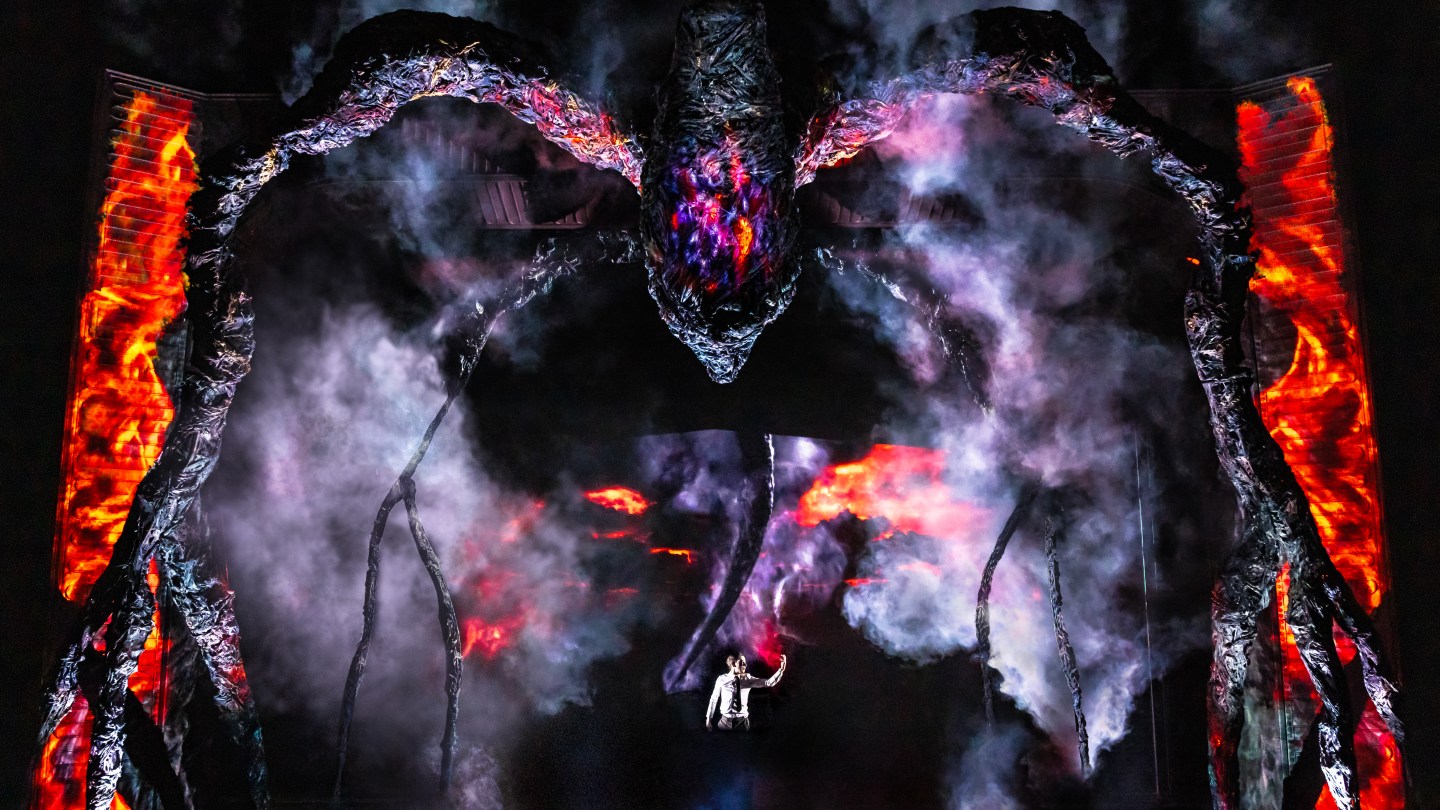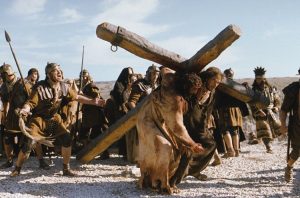
Walking into Stranger Things: The First Shadow on Broadway, theatergoers are greeted by a giant replica of the Creel house at the center of the Netflix series, plush demogorgons for sale and ominous music from the 1950s playing as signs welcome them to Hawkins, Ind.
“You’re going to be right in front of the Mind Flayer!” an attendee in the front few rows says upon taking his seat at an April preview performance.
The show, which is opening at the Marquis Theatre April 22, comes to New York after opening in London’s West End in December 2023 and marks the streaming giant’s biggest foray onto Broadway to date. For Netflix, bringing this show to the stage allows the streaming giant to connect with the large fandom around one of its most popular series, in the same way the company has been launching immersive experiences around Bridgerton and Squid Game.
“It goes back to the core of what we love doing at Netflix, which is telling great stories, and most of the time that’s happening through movies and TV shows, but we also we love doing that in other mediums, and especially in ways that really allows fans to step into the worlds of their favorite characters,” said Josh Simon, vice president of consumer products at Netflix.
But in addition to feeding the fandom, the play, written by Kate Trefry, who is also a writer on the Netflix series, is set up as a prequel to the events in the streaming show and may inform some of what’s to come in the next season.
“It’s totally canon. It’s totally tied into the series with seasons one through four, but also reaching into the future with season five. It had to be this missing puzzle piece that connects all of these different things,” Trefry said.
The play is set in Hawkins in 1959, and features the high school versions of characters from the television series, including Winona Ryder’s Joyce, Sean Astin’s Bob Newby and David Harbour’s Hopper, as well as new characters, including Newby’s sister, Patty. Their high school experience is upended by the arrival of a new student, Henry Creel (who was introduced in the last season), as he begins experimenting with newfound powers.
Director Stephen Daldry had the initial idea for the Stranger Things stage adaptation after being drawn to the challenge of bringing the horror and sci-fi of the show to the stage, and to creating a bridge between television and the stage. Daldry and co-director Justin Martin had previously collaborated with Netflix on The Crown, after directing the stage play, The Audience, it was based on.
The two ran the idea past the Duffer Brothers, who created the Netflix series and are now executive producers on the stage play, tapped theatrical producer Sonia Friedman to lead the production and Trefry as the playwright because of her familiarity with the Stranger Things world. However, she had not previously written for the stage.
“We said ‘Don’t write a play. Write two episodes,” Martin said. “And so these episodes were brilliant, sprawling, everything that we wanted them to be, but also totally impossible to make. There was no limit to her imagination.”
The challenge then, Martin says, was asking “How can we blow up our own imaginations?”
After paring back elements in the first draft, which Trefry said included live animals in water, the team collaborated on a version across months of workshops that still includes multiple jump scares and impressive stage effects, including bodies floating into ceilings, characters suddenly mutilating into monsters and a cold open in which a massive battleship seems to appear out of nowhere.
“The cold open is a huge part of obviously television in general, but we spend weeks and weeks figuring out the cold open on the TV show. So if you’re gonna do Stranger Things, you gotta have a killer cold open,” Trefry said.
The team also wanted to capture the pace and structure of the television series, which involves the group splitting up, working on their respective tasks and then “all of those pieces crashing back together to make sense of a whole.” This, and the pace of the streaming series, is what makes the series “so compulsively watchable,” Trefry says.
Building the Broadway set took six months, which allowed the team time to upgrade some of the special effects from the West End version. For example, one scene, which involves a wall of TV screens that break in rapid succession as a menacing creature comes into view, now involves more practical effects rather than video. The Broadway production also has a shorter run time than the West End production, which is still running at the Phoenix Theatre, as Trefry and the directors went back through the script and finetuned elements for the Broadway actors.
Louis McCartney is reprising his role as Henry Creel on Broadway, in a cast that includes T.R. Knight as Victor Creel, Alison Jaye as Joyce, Gabrielle Nevaeh as Patty Newby, Nicky Eldridge as Bob Newby and Burke Swanson as James Hopper, Jr.

Matthew Murphy and Evan Zimmerman
In crafting the story, Trefry said she also tried to plant “little Easter eggs” for fans of the series, while also creating a storyline that worked for theatergoers who had never seen the TV show. She can’t say much on how the story will tie into the upcoming season of Stranger Things, which is scheduled to premiere in 2025, but notes that seeing the play and then season five will be “very satisfying.”
“I was working on writing season five and the play at the same time, so they’re really kind of two sides of a coin, and I’m really excited for people to be able to take in the full story and see how the these two things across different mediums are in kind of a dialog with each other,” Trefry said.
And as shown in the documentary series about the making of the show, some elements of the play had to be rewritten in London so as not interfere with the storytelling of season five.
“We don’t want to ruin the season five experience for anyone, and we don’t want people to feel left out that are unable to get to New York or to London. But at the same time, you want the play to be meaningful in the play world,” Ross Duffer said an April 21 event for the documentary. “It took a long time to find exactly what that balance is. We’re happy with where it is now.”
Daldry had initially approached the Duffer Brothers after season one of the show, but the timing did not work out until season four ended, Ross Duffer added.
“Even though that season is long, we didn’t have room to put in all that we wanted to about Henry, and so we thought this was the perfect avenue,” he said.
For the Broadway production, the team introduced a moment ahead of the curtain call in which a Netflix screen drops down with the options to “Watch credits” or “Next Episode,” which induced screams from the audience at the April preview as they thought they might get a sneak peak at future storylines. The team plans to add that into the West End version as well.
Part of the goal in bringing so many special effects to the stage was to transcend the physical limitations of the theater and make the experience of seeing the show seem more immersive, Simon said.
“In the audience, you’re sitting there for a couple hours watching something that can feel fairly passive, but the way that they’ve really been able to bring it to life and make it feel like you’re truly like part of an episode of the show, I think, is really unique,” Simon said.
That helps put it in the same category as other Netflix experiences, which include The Queens Ball attraction for Bridgerton, Squid Game: The Experience, a series of immersive games modeled after the show, Netflix Bites, a restaurant with dishes related to titles on the streaming platform, and the upcoming Netflix House, permanent exhibitions of immersive experiences. There’s also an immersive Stranger Things: The Experience, which was developed with the Duffer brothers.
All of these experiences help expand the reach of the streaming platform’s IP in the same way that companies such as Disney and NBCUniversal utilize their theme parks.
“I think this is our version of it,” Simon said. “We’ve now launched 170 of our attractions in 100 cities around the world.”
To be sure, competitors have also been bringing their IP to Broadway, including Disney’s currently running Aladdin and The Lion King and Universal’s Death Becomes Her and Wicked, among many others.

Matthew Murphy and Evan Zimmerman
Last season, Netflix was a co-producer on Patriots, a play written by The Crown’s Peter Morgan, which was also produced by Friedman. That producing credit was, in part, to support Friedman’s work, Simon said, and, at the time, the company said it was developing a screen adaptation of the play. The streaming giant also owns the Roald Dahl Company, which has seen several stage adaptations of its stories, including The Witches and Matilda the Musical.
Netflix hopes to have Stranger Things: The First Shadow run on Broadway for several years. Running costs for the play are expected to be high given the special effects and cast of more than 30 people (‘Don’t even ask me how much Stranger Things is going to cost,” Friedman recently told The New York Times). The first few weeks of previews have been largely well-attended, with strong starting grosses.
As for whether Netflix could bring more stories to the stage, Simon notes that “it’s a great area to tell new stories,” in the same vein as the other experiences the company is bringing to life.
“Whether it’s a restaurant or retail store, a stage play, escape room, a murder-mystery experience, for us, it’s really about connecting fans to the stories. And we’ll explore any medium for that,” Simon said.
#Shadow #Broadway






